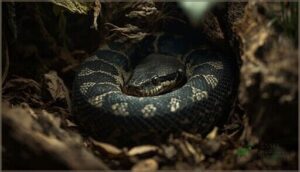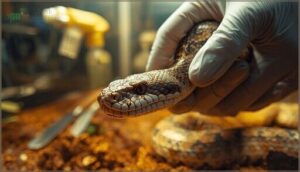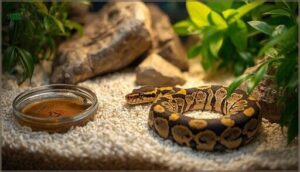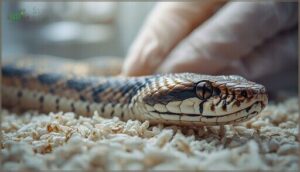This site is supported by our readers. We may earn a commission, at no cost to you, if you purchase through links.

You notice a few darkened scales on your ball python’s belly during routine handling. Within days, those spots have spread, turned into oozing blisters, and your snake refuses to eat. Scale rot moves fast, and without proper treatment, a minor skin infection can become life-threatening.
The good news is that most cases respond well to early intervention when you know what to look for and how to act. From simple Betadine soaks you can do at home to prescription antibiotics for severe infections, snake scale rot treatment options range widely based on how far the infection has progressed.
Understanding the difference between a case you can manage yourself and one that requires a vet visit can save your snake‘s life and prevent unnecessary suffering.
Table Of Contents
Key Takeaways
- Early detection and prompt cleaning with antiseptic solutions like Betadine can stop mild scale rot from becoming life-threatening.
- Dirty enclosures, high humidity, poor ventilation, and cold temperatures are the main reasons snakes develop scale rot.
- Severe or spreading infections need a veterinarian’s care, including prescription antibiotics and possible surgery.
- Keeping your snake’s habitat clean, dry, and within the right temperature and humidity range is the best way to prevent scale rot.
Causes of Snake Scale Rot
Scale rot often starts with problems in your snake’s habitat or care routine. Several key factors can make your snake more vulnerable to this disease. Here’s what you should watch for in your enclosure setup.
High Humidity and Poor Ventilation
When humidity climbs above your snake’s ideal range and air doesn’t circulate properly, you’re setting the stage for bacterial growth and fungal infections. Elevated humidity without adequate ventilation creates a perfect breeding ground for the pathogens that cause scale rot. Studies show that 78% of scale rot cases involve prolonged high humidity lasting over 48 hours.
To prevent moisture-related problems:
- Install proper ventilation systems that allow complete air exchange throughout the enclosure
- Check humidity levels twice daily using a reliable digital hygrometer
- Keep humidity within your snake’s species-specific range (generally 50–60%)
- Make sure your enclosure has mesh screens or drilled holes for adequate airflow
- Address condensation immediately to prevent bacterial amplification on surfaces
Ball pythons, for instance, need humidity above 55% but shouldn’t face persistent spikes over 70%. Without good air movement, bacterial counts can increase tenfold within just two days. Poor ventilation raises your infection risk by 40%, while combining insufficient temperature control with elevated humidity creates conditions where ulcerative skin disease becomes five times more likely.
Humidity monitoring isn’t optional—it’s essential. Maintaining proper humidity levels is vital for reptile health. Strategic vent placement reduces stagnant pockets where moisture accumulates, cutting skin issues by 25%. Think of your enclosure like a bathroom without a fan: dampness lingers, mold appears, and problems multiply. The same principle applies here, except your snake’s health hangs in the balance.
Unsanitary Enclosure Conditions
Dirty enclosures sit at the top of the list—accounting for 60–70% of scale rot cases. When fecal matter, shed skin, and decaying organic material pile up, bacteria and fungi colonize your snake’s living space. Filthy substrate retains moisture, creating bacterial counts up to 10^6 CFU/cm² on surfaces. Daily spot-cleaning and weekly deep-cleaning with reptile-safe disinfectants cut infection risk by over 40%.
Improper reptile husbandry practices can also increase the risk of this condition, as it’s a form of reptile health.
Improper Temperature Regulation
Temperature regulation matters just as much as cleanliness. When your enclosure drops below 21°C (70°F), your snake’s immune system shuts down—studies show 100% mortality in infected snakes housed at 20°C versus just 33% at 26°C. Cold shock weakens defenses against bacteria. Insufficient temperature causes four critical problems:
If your snake’s enclosure drops below 21°C (70°F), its immune system collapses and infection mortality skyrockets
- Immune suppression that prevents fighting infections
- Shedding issues leaving old skin attached
- Disrupted basking behavior reducing natural healing
- Temperature fluctuations stressing your snake’s system
Maintain proper thermal gradients with basking spots at 29–31°C.
Scale Injuries and Skin Damage
Beyond environmental factors, physical trauma and rot go hand-in-hand. Scale abrasions from rough cage furnishings create entry points for bacteria—97.9% of skin lesions show discoloration, while 73.2% involve scale margin erosion.
Mite infestations raise scales, inviting infection. Even minor damaged scales allow blood pooling underneath, turning simple wounds into open sores that progress to ulcerative dermatitis.
Proper wound care prevents these shedding issues from escalating.
Vitamin Deficiencies
Nutritional gaps weaken your snake’s first line of defense—its skin. Vitamin A deficiency compromises epithelial tissue, making scales prone to ulceration and infection. Vitamin C shortfalls delay wound healing, while imbalanced Calcium Balance and Vitamin D disrupt scale regeneration.
- Vitamin A shortage: Dry, flaky skin invites bacterial invasion
- Vitamin C deficiency: Wounds linger, creating infection hotspots
- Over-Supplementation risks: Excess vitamin A causes toxic skin lesions
Proper snake diet prevents these snake health and husbandry pitfalls.
Recognizing Scale Rot Symptoms
Catching scale rot early can make all the difference between a quick recovery and a serious health crisis. Your snake’s scales will tell the story if you know what to look for.
Here are the key warning signs that indicate your snake needs immediate attention.
Scale Discoloration (Brown, Yellow, Green, Black)
Catching scale discoloration early can save your snake’s life. Identifying these scale rot symptoms quickly improves treatment success rates dramatically.
Brown patches—the most common symptom appearing in 65% of cases—signal bacterial infection starting. Yellow indicators suggest pus or fungal involvement. Green signals point to Pseudomonas bacteria thriving in damp conditions. Black necrosis marks severe tissue death requiring urgent care.
Raised or Fluid-Filled Blisters
Raised scales on your snake’s belly or sides often mean blood or fluid has pooled underneath. Up to 87% of early scale rot cases show these fluid-filled blisters during examination.
Bacterial cultures from blister fluid reveal Aeromonas or Pseudomonas in most cases. These blisters progress to ulcers within five to seven days without proper antibiotic ointment treatment and veterinary assistance.
Ulcers and Raw Skin Lesions
When blisters rupture, they expose raw tissue underneath—this is where ulcer diagnosis becomes critical. These open wounds signal that bacteria have breached your snake’s first line of defense.
Watch for these clinical characteristics requiring immediate wound care:
- Necrotic tissue with foul-smelling discharge on ventral scales
- Red, weeping lesions slow to heal despite antiseptic solution treatment
- Bleeding edges around wound sites indicating active infection
- Exposed underlying tissue vulnerable to lesion pathogens like Pseudomonas
- Septicemia risk increases dramatically without proper wound management and treatment outcomes monitoring
Behavioral Changes and Lethargy
Your snake’s hiding more than usual or barely moving? Lethargy and behavioral changes often appear before visible lesions develop. Watch for reduced activity, increased hiding behavior, and appetite loss—these symptoms of scale rot signal your snake’s in pain and discomfort.
Infection drains energy fast, causing weakness and withdrawal. Severe cases may progress to septicemia, making early recognition of these snake behavior shifts critical.
Immediate Actions After Identifying Scale Rot
Once you spot scale rot on your snake, quick action makes all the difference in stopping the infection from spreading. The first few steps focus on separating your snake from other reptiles, cleaning the affected areas gently, and watching closely for any changes.
Here’s what you need to do right away to give your snake the best chance at a full recovery.
Quarantine and Isolation Procedures
When you spot scale rot, you’ll need to isolate the snake immediately—this infection is contagious. Move your snake to a separate quarantine tank with dedicated equipment to prevent spread.
Plan for at least 30 days of quarantine, though 60 to 90 days ensures better monitoring. Use strict hygiene protocols: disposable gloves, daily health checks, and thorough disinfection between handling sessions.
Cleansing Techniques for Affected Areas
After isolating your snake, you’ll need to clean the infected scales properly. Antiseptic solutions like diluted betadine or chlorhexidine work best—soak or gently wipe the affected area to loosen debris.
- Debris removal: Use sterile gauze after soaking to clear crusty material
- Cleaning frequency: Twice daily for mild cases, more if needed
- Drying protocols: Pat thoroughly dry with disposable towels
- Hand hygiene: Wear gloves to prevent cross-contamination
This gets the skin ready for topical treatments.
Monitoring for Worsening Symptoms
Once cleaning is complete, you’ll need to track how your snake responds. Daily checks catch problems fast—watch for lesion expansion, new blisters, or foul odor and exudate. Early detection separates mild cases from those needing veterinary care.
Document snake symptoms daily with photos.
| Watch For | Action Needed |
|---|---|
| Appetite changes, lethargy | Document weight, consider snake vet care |
| Pus, bleeding, shedding issues | Escalate treatment immediately |
| Septicemia signs (weakness, discoloration spreading) | Emergency veterinary care |
Home Treatment Options for Scale Rot
If you’ve caught scale rot early, you can often treat it at home with the right approach. The key is combining daily care routines with immediate improvements to your snake’s environment.
Here are five treatment options that work together to help your snake recover.
Betadine Soaks and Antiseptic Cleaning
When treating scale rot at home, you’ll find Betadine soaks work wonders for mild infections. Dilute one part Betadine solution to about ten parts lukewarm water—it should look like weak tea.
Here’s your step-by-step protocol:
- Soak your snake for 10-30 minutes daily in shallow water (chest height only)
- Gently dry afterward, removing any crusty material
- Replace substrate with clean paper towels immediately
- Monitor for improvement within several days
- Combine with strict enclosure cleaning for best results
This antiseptic solution kills bacteria effectively, supporting wound healing and scale rot prevention through consistent reptile hygiene practices.
Application of Antibiotic Ointments
After your antiseptic soak, topical therapy becomes your next weapon for infection control. Apply a thin layer of triple antibiotic ointment (without pain relievers) directly to dried lesions once or twice daily. Silver sulfadiazine cream offers stronger antimicrobial action for stubborn cases.
Let ointment absorb 30-120 minutes before returning your snake to its enclosure. You should see wound healing progress within 7-14 days when combined with strict hygiene. If lesions worsen after three weeks of treating scale rot at home, veterinary antibiotics become necessary.
| Ointment Type | Best For |
|---|---|
| Triple antibiotic (Neosporin) | Mild, early-stage scale rot |
| Silver sulfadiazine | Moderate to severe bacterial infection |
| Polymyxin B-based | Abrasions and fresh wounds |
| Prescription combinations | Non-responsive or spreading lesions |
| Avoid analgesic formulas | All reptiles (toxic risk) |
Use of Antimicrobial Sprays (e.g., Vetericyn)
Modern antimicrobial sprays like Vetericyn offer a significant advancement in reptile wound care. You’ll find hypochlorous acid technology fights bacteria without the sting of traditional antiseptic solutions. Apply the spray directly to clean, dry lesions three to four times daily for best results.
Benefits include:
- Non-toxic formula safe near eyes and mouth
- Works alongside antibiotic ointment treatments
- No alcohol or steroids to irritate damaged scales
- Maintains moisture for faster healing
- Shows visible improvement within 48-72 hours
This antimicrobial approach complements your scale rot treatment protocol effectively.
Improving Enclosure Hygiene and Substrate
Without a clean home, your snake can’t heal properly. Daily spot-cleaning removes waste immediately, while weekly deep cleaning eliminates hidden bacteria. Replace substrate with paper towels during treatment—they’re non-porous and show new discharge clearly.
| Task | Frequency | Focus |
|---|---|---|
| Spot clean | Daily | Feces, urates, spills |
| Deep clean | Weekly | Disinfect all surfaces |
| Substrate change | Every 3-4 days | Maintain dryness |
Proper sanitation methods cut infection risk by 40%.
Regulating Humidity and Temperature
Your snake’s environment needs careful attention—humidity levels between 40% and 60% prevent bacterial infection, while temperature gradients of 75°F to 91°F support healing. Use digital hygrometers for humidity monitoring and thermostats for temperature regulation.
Species requirements vary: corn snakes thrive at 40-50% humidity, ball pythons at 50-60%. Seasonal adjustments matter too. Proper thermostat calibration prevents hotspots that mimic scale rot symptoms. These preventative measures complement enclosure hygiene during treatment.
When to Seek Veterinary Care
Home remedies work well for mild scale rot, but some infections need professional care. If your snake’s condition worsens despite treatment or you notice signs the infection is spreading, it’s time to call a vet.
Here’s what situations require veterinary attention and what treatments your vet might recommend.
Signs of Severe or Spreading Infection
If your snake’s scale rot isn’t improving after 48-72 hours of home care, you’re likely dealing with a severe infection that needs veterinary attention. Watch for these critical warning signs:
- Pus-filled blisters with foul odor indicating deep tissue damage and bacterial invasion
- Rapid spread across body regions with blood pooling beneath raised scales
- Systemic symptoms like lethargy, loss of appetite, or weakness suggesting septicemia risk
Necrotic tissue, secondary infections, and necrosis signal urgent professional intervention is necessary.
Prescription Antibiotics and Topical Medications
Your vet will prescribe systemic antibiotics—like enrofloxacin or azithromycin—to knock out the bacterial infection from within. These medications target pathogens that topical antibiotics can’t reach alone.
You’ll also receive topical medication application instructions, often using silver sulfadiazine cream or Vetericyn spray.
Be aware: improper dosing risks antibiotic resistance, while some injection methods carry injection risks like tissue damage, so follow veterinary protocols precisely to guarantee medication safety and topical efficacy.
Advanced Treatments and Potential Surgery
When topical treatments fail, surgical intervention becomes necessary. Your vet will perform surgical debridement to remove necrotic tissue—think of it as clearing away dead wood so healthy tissue can regenerate.
Hospitalization care may be required, combining systemic therapies with wound management protocols. Anesthesia risks in snakes are minimal but present.
With proper complication management, long-term outcomes exceed 90% success rates.
Recovery Timeline and Follow-Up Care
After treatment begins, initial improvement appears within 7–10 days. Full resolution takes 3–6 weeks for moderate cases, sometimes extending to 3 months for severe infections. Tissue regeneration occurs through natural shedding cycles, though scar formation may persist.
You’ll need follow-up visits every 2–4 weeks. Long-term wellness depends on environmental control, relapse prevention through daily hygiene, and sometimes recovery feeding with probiotics to support tissue repair.
Frequently Asked Questions (FAQs)
Can scale rot spread to other reptiles?
It’s no coincidence that poor enclosure hygiene and environmental contamination can foster cross-species transmission. While scale rot isn’t highly contagious, documented cases show bacterial infection can spread through contaminated surfaces.
Quarantine effectiveness hinges on strict isolation and cleaning for reptile health.
Is scale rot contagious to humans or pets?
Scale rot isn’t contagious to humans or pets outside reptiles. Human transmission risk is extremely low, since typical bacteria don’t cause zoonotic disease.
Pet contagion factors matter only for other reptiles—good hygiene best practices protect everyone’s health.
Will scale rot affect future shedding cycles?
Yes, scale rot can trigger shedding abnormalities and skin shedding problems, especially if secondary infections or blisters develop. With proper care and preventative strategies, most snakes regain normal scale regeneration and shedding cycles, showing a positive long-term prognosis.
Can stress worsen scale rot in snakes?
Imagine stress acting like a thief, quietly stealing your snake’s immune defenses. Elevated corticosterone levels and stress immunosuppression make scale rot much worse.
Behavioral changes signal declining snake health—so preventative measures in the captive environment are absolutely essential.
Are certain snake species more prone to scale rot?
You’ll notice ball pythons top the list for Python susceptibility, while corn snakes show Arboreal resistance.
Juvenile vulnerability and Morph influence, like albino or “super black pastel,” can raise risk.
Genetic predispositions also shape snake species’ scale rot outcomes.
Conclusion
Swift, smart steps safeguard your snake’s skin. Spotting scale rot early and selecting the right snake scale rot treatment options means you’re steering your pet from suffering toward swift recovery.
Simple soaks and substrate swaps can stop mild cases, while severe symptoms signal it’s time to seek a specialist.
Staying vigilant, cleaning consistently, and controlling conditions keeps your ball python healthy. The journey from blisters to healing begins with your careful attention—because every scale counts in your care.
- http://veterinarymedicinejournal.usamv.ro/pdf/vol.LVIII_4/Art12.pdf
- https://www.petmd.com/reptile/conditions/cardiovascular/c_rp_septicemia
- https://dr.lib.iastate.edu/server/api/core/bitstreams/15df7db7-a2d8-4513-a541-ac1aff2bc49a/content
- https://www.reddit.com/r/kingsnakes/comments/1i5fab4/humidity_issues_and_scale_rot/
- https://tempcube.io/blogs/temperature-humidity/ensuring-proper-humidity-levels-in-your-reptile-enclosure













